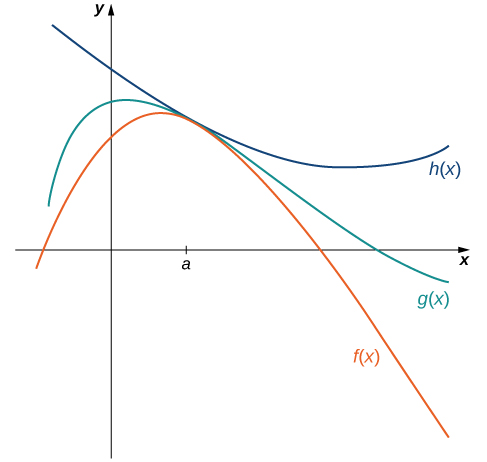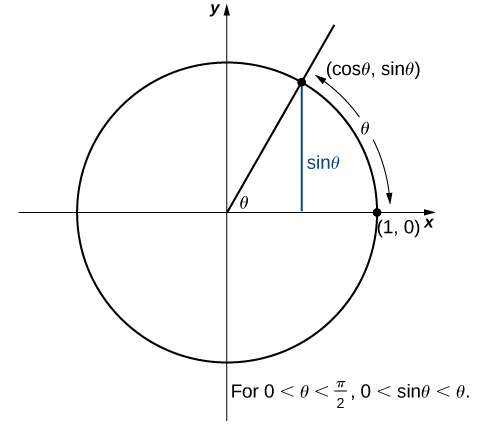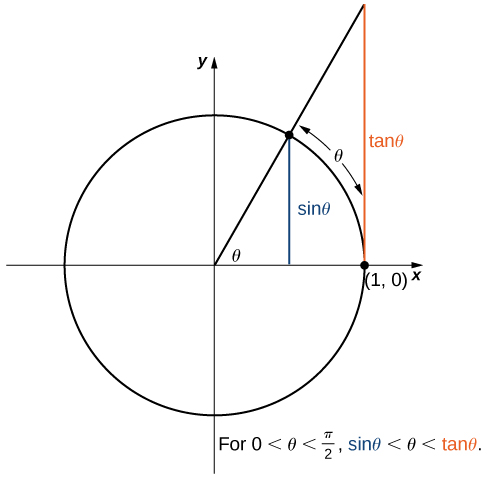Learning Outcomes
- Evaluate the limit of a function by using the squeeze theorem
The techniques we have developed thus far work very well for algebraic functions, but we are still unable to evaluate limits of very basic trigonometric functions. The next theorem, called the squeeze theorem, proves very useful for establishing basic trigonometric limits. This theorem allows us to calculate limits by “squeezing” a function, with a limit at a point [latex]a[/latex] that is unknown, between two functions having a common known limit at [latex]a[/latex]. Figure 5 illustrates this idea.

Figure 5. The Squeeze Theorem applies when [latex]f(x)\le g(x)\le h(x)[/latex] and [latex]\underset{x\to a}{\lim}f(x)=\underset{x\to a}{\lim}h(x)[/latex].
The Squeeze Theorem
Let [latex]f(x), \, g(x)[/latex], and [latex]h(x)[/latex] be defined for all [latex]x\ne a[/latex] over an open interval containing [latex]a[/latex]. If
for all [latex]x\ne a[/latex] in an open interval containing [latex]a[/latex] and
where [latex]L[/latex] is a real number, then [latex]\underset{x\to a}{\lim}g(x)=L[/latex].
Example: Applying the Squeeze Theorem
Apply the Squeeze Theorem to evaluate [latex]\underset{x\to 0}{\lim}x \cos x[/latex].
Try It
Use the Squeeze Theorem to evaluate [latex]\underset{x\to 0}{\lim}x^2 \sin \dfrac{1}{x}[/latex].
Watch the following video to see the worked solution to the above Try It.
We now use the squeeze theorem to tackle several very important limits. Although this discussion is somewhat lengthy, these limits prove invaluable for the development of the material in both the next section and the next module. The first of these limits is [latex]\underset{\theta \to 0}{\lim} \sin \theta[/latex]. Consider the unit circle shown in Figure 7. In the figure, we see that [latex] \sin \theta [/latex] is the [latex]y[/latex]-coordinate on the unit circle and it corresponds to the line segment shown in blue. The radian measure of angle θ is the length of the arc it subtends on the unit circle. Therefore, we see that for [latex]0<\theta <\frac{\pi }{2}, \, 0 < \sin \theta < \theta[/latex].

Figure 7. The sine function is shown as a line on the unit circle.
Because [latex]\underset{\theta \to 0^+}{\lim}0=0[/latex] and [latex]\underset{\theta \to 0^+}{\lim}\theta =0[/latex], by using the Squeeze Theorem we conclude that
To see that [latex]\underset{\theta \to 0^-}{\lim} \sin \theta =0[/latex] as well, observe that for [latex]-\frac{\pi }{2} < \theta <0, \, 0 < −\theta < \frac{\pi}{2}[/latex] and hence, [latex]0 < \sin(-\theta) < −\theta[/latex]. Consequently, [latex]0 < -\sin \theta < −\theta[/latex] It follows that [latex]0 > \sin \theta > \theta[/latex]. An application of the Squeeze Theorem produces the desired limit. Thus, since [latex]\underset{\theta \to 0^+}{\lim} \sin \theta =0[/latex] and [latex]\underset{\theta \to 0^-}{\lim} \sin \theta =0[/latex],
Next, using the identity [latex] \cos \theta =\sqrt{1-\sin^2 \theta}[/latex] for [latex]-\frac{\pi}{2}<\theta <\frac{\pi}{2}[/latex], we see that
We now take a look at a limit that plays an important role in later modules—namely, [latex]\underset{\theta \to 0}{\lim}\frac{\sin \theta}{\theta}[/latex]. To evaluate this limit, we use the unit circle in Figure 7. Notice that this figure adds one additional triangle to Figure 8. We see that the length of the side opposite angle [latex]\theta[/latex] in this new triangle is [latex]\tan \theta[/latex]. Thus, we see that for [latex]0 < \theta < \frac{\pi}{2}, \, \sin \theta < \theta < \tan \theta[/latex].

Figure 8. The sine and tangent functions are shown as lines on the unit circle.
By dividing by [latex]\sin \theta [/latex] in all parts of the inequality, we obtain
Equivalently, we have
Since [latex]\underset{\theta \to 0^+}{\lim}1=1=\underset{\theta \to 0^+}{\lim}\cos \theta[/latex], we conclude that [latex]\underset{\theta \to 0^+}{\lim}\frac{\sin \theta}{\theta}=1[/latex]. By applying a manipulation similar to that used in demonstrating that [latex]\underset{\theta \to 0^-}{\lim}\sin \theta =0[/latex], we can show that [latex]\underset{\theta \to 0^-}{\lim}\frac{\sin \theta}{\theta}=1[/latex]. Thus,
In the example below, we use this limit to establish [latex]\underset{\theta \to 0}{\lim}\frac{1- \cos \theta}{\theta}=0[/latex]. This limit also proves useful in later modules.
Example: Evaluating an Important Trigonometric Limit
Evaluate [latex]\underset{\theta \to 0}{\lim}\dfrac{1- \cos \theta}{\theta}[/latex]
Watch the following video to see the worked solution to Example: Evaluating an Important Trigonometric Limit
Try It
Evaluate [latex]\underset{\theta \to 0}{\lim}\dfrac{1- \cos \theta}{\sin \theta}[/latex]
Try It
Activity: Deriving the Formula for the Area of a Circle
Some of the geometric formulas we take for granted today were first derived by methods that anticipate some of the methods of calculus. The Greek mathematician Archimedes (ca. 287−212 BCE) was particularly inventive, using polygons inscribed within circles to approximate the area of the circle as the number of sides of the polygon increased. He never came up with the idea of a limit, but we can use this idea to see what his geometric constructions could have predicted about the limit.
We can estimate the area of a circle by computing the area of an inscribed regular polygon. Think of the regular polygon as being made up of [latex]n[/latex] triangles. By taking the limit as the vertex angle of these triangles goes to zero, you can obtain the area of the circle. To see this, carry out the following steps:
- Express the height [latex]h[/latex] and the base [latex]b[/latex] of the isosceles triangle in Figure 9 in terms of [latex]\theta[/latex] and [latex]r[/latex].

Figure 9.
- Using the expressions that you obtained in step 1, express the area of the isosceles triangle in terms of [latex]\theta[/latex] and [latex]r[/latex].
(Substitute [latex](\frac{1}{2})\sin \theta[/latex] for [latex]\sin(\frac{\theta}{2}) \cos(\frac{\theta}{2})[/latex] in your expression.) - If an [latex]n[/latex]-sided regular polygon is inscribed in a circle of radius [latex]r[/latex], find a relationship between [latex]\theta[/latex] and [latex]n[/latex]. Solve this for [latex]n[/latex]. Keep in mind there are [latex]2\pi[/latex] radians in a circle. (Use radians, not degrees.)
- Find an expression for the area of the [latex]n[/latex]-sided polygon in terms of [latex]r[/latex] and [latex]\theta[/latex].
- To find a formula for the area of the circle, find the limit of the expression in step 4 as [latex]\theta[/latex] goes to zero. (Hint: [latex]\underset{\theta \to 0}{\lim}\frac{(\sin \theta)}{\theta}=1[/latex].)
The technique of estimating areas of regions by using polygons is revisited in Module 5: Integration.
